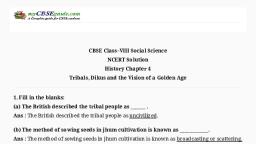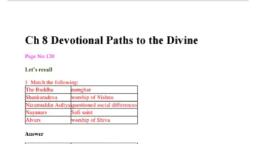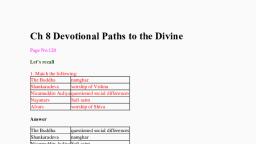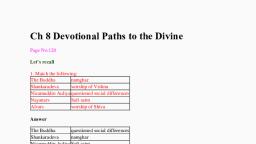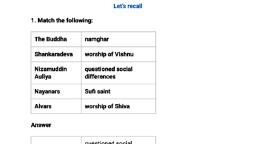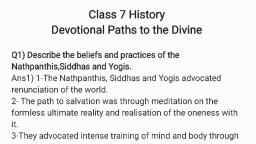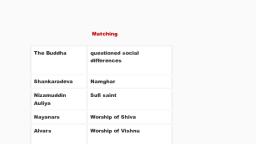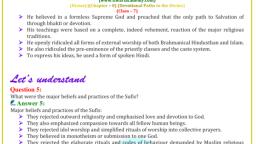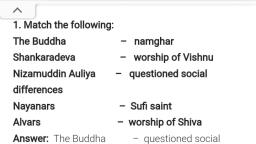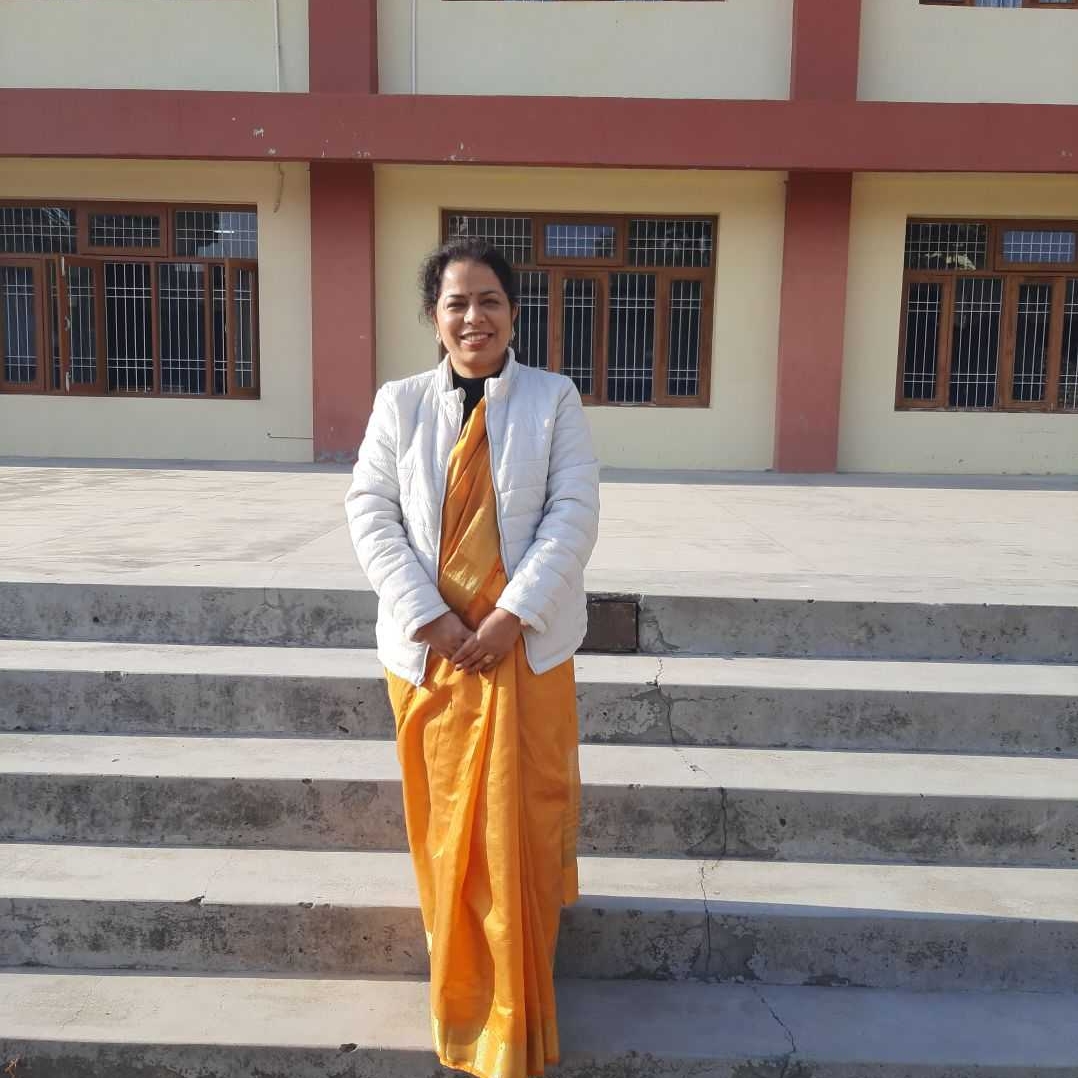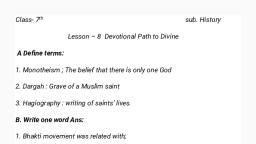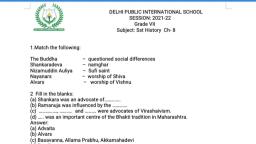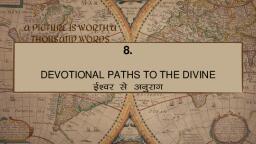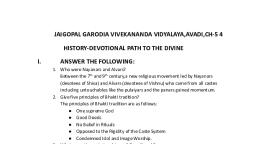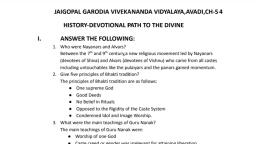Page 2 :
Q3: Describe the beliefs and practices of the Nathpanthis, Siddhas and Yogis., Ans: Followings are the beliefs and practices of Nathpanthis, Siddhas and Yogis:, The Nathpanthis, Siddhas, and Yogis advocated renunciation of the world., To them, the path of salvation lay in meditation on the formless Ultimate Reality and, the realisation of oneness with it., To achieve this they advocated intense training of the mind and body through yoga, asanas, breathing exercises and meditation., They criticised the rituals and other aspects of conventional religion and the social, order, using simple, logical arguments., These groups became particularly popular among “low” castes., , Q4: What were the major ideas expressed by Kabir? How did he express these?, Ans: Kabir was probably lived in 15th-16th centuries, was one of the most influential saints., His major ideas were as under:, Kabir's teachings were based on a complete, indeed vehement, rejection of the major, religious traditions., His teachings openly ridiculed all forms of external worship of both Brahmanical, Hinduism and Islam, the pre-eminence of the priestly classes and the caste system., Kabir believed in a formless Supreme God and preached that the only path to, salvation was through bhakti or devotion., The way by which Kabir expressed his ideas are as under:, The language of his poetry, which was a form of spoken Hindi widely understood by, common people., He also wrote verses called sakhis, pads and dohas which are still popular among, people today., His Dohas and Sakhis have been sung by popular bhajan singers., , Q5: What were the major beliefs and practices of the Sufis?, Ans: The Sufis were Muslim mystics. Their major beliefs and practices were as under:, , Material downloaded from myCBSEguide.com., , 2/5
Page 3 :
They rejected outward religiosity and emphasised love and devotion to God and, compassion towards all fellow human beings., They believed in one God., The rejected idol worship., The Sufis rejected the elaborate rituals and codes of behaviour demanded by Muslim, religious scholars., The Sufis believed in union with God as a lover seeking his beloved., The Sufis developed various methods of training using Zikr (chanting of a name or, sacred formula), contemplation, sama (singing), raqs (dancing), discussion of, parables, breath control, etc. under the guidance of a master or pir. Thus emerged the, silsilas, a genealogy of Sufi teachers, each following a slightly different method, (tariqa) of instruction and ritual practice.., The Sufi masters held their assemblies in their khanqahs or hospices where they, discussed spiritual matters, sought the blessings of the saints in solving their worldly, problems, or simply attended the music and dance sessions., , Q6: Why do you think many teachers rejected prevalent religious beliefs and practices?, Ans: Many teachers rejected prevalent religious beliefs and practices due to the following, reasons:, these beliefs were cumbersome and difficult to follow., Many Prevalent beliefs and practices based on useless rituals which were no way, proper in the eyes of many of the teachers., these beliefs led to social inequality and created differences between classes., the religious teachings favoured the privileged ones., These religious beliefs and practices discriminated against lower classes., The teachers felt attracted to the idea of a Supreme God who could deliver humans, from bondage if approached with devotion (or bhakti)., , Q7: What were the major teachings of Baba Guru Nanak?, Ans: Following are the major teachings of Baba Guru Nanak:, Baba Guru Nanak insisted that his followers must be householders and should adopt, productive and useful occupations., Material downloaded from myCBSEguide.com., , 3/5
Page 4 :
Baba Guru Nanak emphasised on the worship of one God., He insisted that caste, creed or gender were irrelevant for attaining liberation. His, ideas of liberation was not that of a state of inert bliss but rather the pursuit of active, life with a strong sense of social commitment., He gave the motto of nam, dan and isnan, which meant right worship, the welfare of, others and purity of conduct., The sacred space thus created by Guru Nanak was known as dharmsal. It is now, known as Gurdwara., His teachings are now remembered as nam-japna, kirt-karna and vand-chhakna,, which also underline the importance of right belief and worship, honest living, and, helping others., , Q8: For either the Virashaivas or the saints of Maharashtra, discuss their attitude, towards caste., Ans: Both Virashaivas and the saints of Maharashtra rejected social inequality and caste, differences., The Virashaivas argued strongly for the equality of all human beings and they were, against Brahmanical ideas about caste and the treatment of women., They were also against all forms of ritual and idol worship., The saints of Maharashtra like Jnaneshwar, Namdev, Eknath and Tukaram- rejected, all forms of ritualism, outward display of piety and social differences based on birth., They preferred to live with their families, earning their livelihood like any other, person, while humbly serving fellow human beings in need., They insisted that Bhakti lay in sharing others pain., As the famous Gujarati saint Narsi Mehta said," They are Vaishnavas who understand, the pain of others.", , Q9: Why do you think ordinary people preserved the memory of Mirabai?, Ans:, Mirabai was a Rajput Princess married into the royal family of Mewar in the sixteenth, century., Mirabai became a disciple of Ravidas, a saint from a caste considered “untouchable”., Material downloaded from myCBSEguide.com., , 4/5
Page 5 :
She was devoted to Krishna and composed innumerable bhajans expressing her, intense devotion., Ordinary people have preserved the memory of Mirabai because her songs openly, challenged the norms of the upper castes., Due to her actions against royal upper castes, she became popular within the, ordinary masses of Rajasthan and Gujrat., , Material downloaded from myCBSEguide.com., , 5/5





























